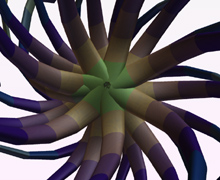Art by Natural Selection
by George Fifield
In 1835, Charles Darwin visited the Galápagos Islands to study
its fascinating flora and fauna. Years later, ruminating on the
patterns of diversity he found there, particularly on 14 species of
birds later known as Darwin's Finches, he came to understand the
powerful evolutionary process that he called natural selection. He
realized that the different Finches on the various islands all shared
a common ancestry, but through natural selection had evolved over time
to take advantage of different ecological niches. Darwin's
explanation of how this process allowed life to create and modify
complex designs is the most awe-inspiring and revolutionary discovery
of the last 150 years.

Karl Sims - Creature from Galápagos |
Sims's work is perhaps better known abroad then in this country. A graduate of M.I.T. where he studied biotechnology, he became research scientist and artist-in-residence at Thinking Machines Corporation in Cambridge. There he was able to work on series of world famous computer-animated shorts, culminating in Liquid Selves produced for Art Futura '92 and the Barcelona World Fair. His first major interactive installation Genetic Images which opened in 1993 at the Centre Pompidou in Paris, allowed viewers to produce two dimensional still images in the same way Galápagos produces three demensional moving objects.
The Galápagos installation is composed of twelve monitors arranged in a row, each with its own footpad. On each screen is a three dimensional creature generated by a mathematical equation. The creatures have physical characteristics, like size, color and shape; they also have life-like characteristics like motion and articulated body parts. They throb and undulate; they move to and fro. When the program first starts, the creatures are very simple in shape and color. The viewer is expected to simply "choose" a creature by standing on the footpad in front of that creature's monitor.
Then the fun begins. The creatures not chosen fade from the other screens. A group of small bubbles radiate out from the surviving creature to the now blank screens. From these seeds grow a second generation whose characteristics derive from their (chosen) parent. But they are not identical: the computer adds changes in the form of random mutations to the equation (the genotype) that formed the parent creature. Some of these changes are minimal, but some offspring are obviously different from their parents. They may display a different color or shape or movement. Now the viewer chooses again, by standing on a different foot pad. Over time, the generations of creatures not only change form but, as Darwin predicts, they fast become amazingly complex.
As in real life, reproduction can be sexual. That is, two viewers, stepping on two foot pads can create a generation which mixes the genes of the two sibling parents. The computer and viewers are now engaged in a dance as old as life. The computer is performing the random mutations on a gene pool and the viewer is acting as natural selection, choosing (for aesthetic reasons) which organism will survive to reproduce.
The results are beautiful and other worldly. Some of them become recognizably life-like, as if Dale Chululy glass anemones were to suddenly spring to life, growing and breathing. Others are more crystalline, with faceted shapes and grasping metallic appendages. Two things quickly become clear: the creatures that you, the viewer, creates have never existed before and the process of selection generates creatures with great individual resonance. They are, after all, your own creations, a collaboration between viewer and machine.
In Sims' work, the viewer becomes part of the creative process in an immediate and very satisfying way. In Galápagos, the process itself is the real art. Sims has created a remarkable allegory of the mechanism that four and a half billion years ago began the most complex design of all - life.
George Fifield is the director of the Boston Cyberarts Festival and curator of Media Arts at the DeCordova Museum and Sculpture Park in Lincoln, MA. This article was first published in Art New England August / September 1997. © 1997, George Fifield